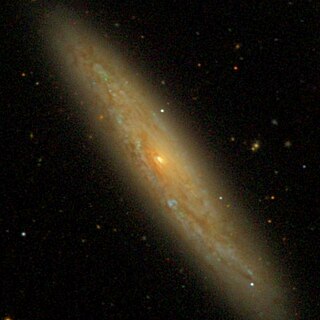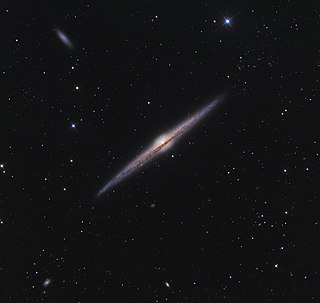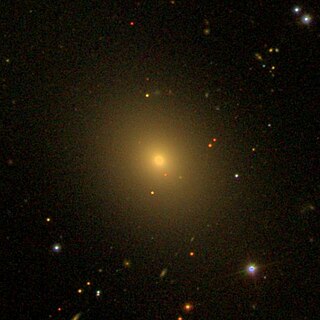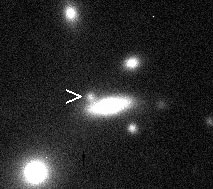Related Research Articles

Hoag's Object is an unusual ring galaxy in the constellation of Serpens Caput. It is named after Arthur Hoag, who discovered it in 1950 and identified it as either a planetary nebula or a peculiar galaxy. The galaxy has a D25 isophotal diameter of 45.41 kiloparsecs (148,000 light-years).

Galaxy Evolution Explorer was a NASA orbiting space telescope designed to observe the universe in ultraviolet wavelengths to measure the history of star formation in the universe. In addition to paving the way for future ultraviolet missions, the space telescope allowed astronomers to uncover mysteries about the early universe and how it evolved, as well as better characterize phenomena like black holes and dark matter. The mission was extended three times over a period of 10 years before it was decommissioned in June 2013. GALEX was launched on 28 April 2003 and decommissioned in June 2013.

The Sloan Digital Sky Survey or SDSS is a major multi-spectral imaging and spectroscopic redshift survey using a dedicated 2.5-m wide-angle optical telescope at Apache Point Observatory in New Mexico, United States. The project began in 2000 and was named after the Alfred P. Sloan Foundation, which contributed significant funding.

Messier 65 is an intermediate spiral galaxy about 35 million light-years away in the constellation Leo, within its highly equatorial southern half. It was discovered by Charles Messier in 1780. With M66 and NGC 3628, it forms the Leo Triplet, a small close group of galaxies.
The Digitized Sky Survey (DSS) is a digitized version of several photographic astronomical surveys of the night sky, produced by the Space Telescope Science Institute between 1983 and 2006.

The Crescent Nebula is an emission nebula in the constellation Cygnus, about 5000 light-years away from Earth. It was discovered by William Herschel in 1792. It is formed by the fast stellar wind from the Wolf-Rayet star WR 136 colliding with and energizing the slower moving wind ejected by the star when it became a red giant around 250,000 to 400,000 years ago. The result of the collision is a shell and two shock waves, one moving outward and one moving inward. The inward moving shock wave heats the stellar wind to X-ray-emitting temperatures.

NGC 3132 is a bright and extensively studied planetary nebula in the constellation Vela. Its distance from Earth is estimated at 613 pc or 2,000 light-years.

NGC 3596 is an intermediate spiral galaxy in the constellation Leo. It was discovered by William Herschel 1784. It is located below the star Theta Leonis (Chertan). It is a member of the Leo II Groups, a series of galaxies and galaxy clusters strung out from the right edge of the Virgo Supercluster.

NGC 3877 is a type Sc spiral galaxy that was discovered by William Herschel on February 5, 1788. It is located below the magnitude 3.7 star Chi Ursae Majoris in Ursa Major.

NGC 4565 is an edge-on spiral galaxy about 30 to 50 million light-years away in the constellation Coma Berenices. It lies close to the North Galactic Pole and has a visual magnitude of approximately 10. It is known as the Needle Galaxy for its narrow profile. First recorded in 1785 by William Herschel, it is a prominent example of an edge-on spiral galaxy.

NGC 57 is an elliptical galaxy in the constellation Pisces. It was discovered on 8 October 1784 by astronomer William Herschel.

NGC 7635, also known as the Bubble Nebula, Sharpless 162, or Caldwell 11, is an H II region emission nebula in the constellation Cassiopeia. It lies close to the open cluster Messier 52. The "bubble" is created by the stellar wind from a massive hot, 8.7 magnitude young central star, SAO 20575 (BD+60°2522). The nebula is near a giant molecular cloud which contains the expansion of the bubble nebula while itself being excited by the hot central star, causing it to glow. It was discovered in November 1787 by William Herschel. The star BD+60°2522 is thought to have a mass of about 44 M☉.

The Iris Nebula is a bright reflection nebula in the constellation Cepheus. The designation NGC 7023 refers to the open cluster within the larger reflection nebula designated LBN 487.

NGC 7 is a barred spiral galaxy located in the Sculptor constellation. It was discovered by English astronomer John Herschel in 1834, who was using an 18.7 inch reflector telescope at the time. Astronomer Steve Gottlieb described the galaxy as faint, albeit large, and edge-on from the perspective of the Milky Way; he also noted how the galaxy could only be observed clearly with peripheral vision, not by looking directly at it.

NGC 5177 is a lenticular galaxy. Based on a redshift of 6467 km/s the galaxy is crudely estimated to be about 300 million light-years away.
GALEX Arecibo SDSS Survey (GASS) is a large targeted survey at Arecibo Observatory that has been underway since 2008 to measure the neutral hydrogen content of a representative sample of approximately 1000 massive galaxies selected using the Sloan Digital Sky Survey and GALEX imaging surveys. The telescope being used is the world's largest single-dish radio telescope and can receive signals from distant objects.

NGC 174 is a barred spiral or lenticular galaxy around 159 million light-years away in the constellation Sculptor. It was discovered on 27 September 1834 by astronomer John Herschel.

NGC 492, also occasionally referred to as PGC 4976 or GC 280, is a barred spiral galaxy in the constellation Pisces. It is located approximately 590 million light-years from Earth and was discovered on December 6, 1850 by Irish engineer Bindon Blood Stoney. Although John Dreyer, creator of the New General Catalogue, credits the discovery to astronomer William Parsons, 3rd Earl of Rosse, he notes that many of his claimed discoveries were made by one of his assistants. In the case of NGC 492, the discovery was made by Bindon Stoney, who discovered it along with NGC 486, NGC 490 and NGC 500 during his observation of NGC 488 using Lord Rosse's 72" telescope.

NGC 3315 is a lenticular galaxy located about 185 million light-years away in the constellation Hydra. It was discovered by astronomer Edward Austin on March 24, 1870. It is a member of the Hydra Cluster.

NGC 676 is a lenticular Seyfert 2 galaxy about 18.7 Mly away in the constellation Pisces. It can be seen near the star α Piscium. Located close to the celestial equator, it is visible from both hemispheres. BD +04 0244, a star with a visual magnitude of 10.44, is superposed 5.1 arc seconds south-southwest of the nucleus. It is one of the 621 galaxies described in Marat Arakelian's catalog of high-surface-brightness galaxies.
References
- ↑ Muir, Hazel (2007-03-22). "WikiSky brings sky gazing to the (online) masses". newscientist.com. New Scientist writer. Archived from the original on 2016-03-21. Retrieved 2022-08-22.
- ↑ "Sky-Map Site To Show The Beauty Of The Universe To Everybody". skynightly.com. Sky Nightly. 2007-02-01. Retrieved 2022-08-22.
- ↑ "Other Astronomy Image Services". SkyView. NASA. 2007-05-21. Archived from the original on 2007-05-21. Retrieved 2022-08-22.
- ↑ "Copyright - DSS2 images". 2009-02-23. Archived from the original on September 9, 2008. Retrieved 2010-05-06.
- ↑ "The DSS datarights". Multimission Archive at STScI. 2007-06-12. Retrieved 2010-05-06.
- ↑ Michael L. Evans. "Image use policy". Sloan Digital Sky Survey. Retrieved 2010-05-06.